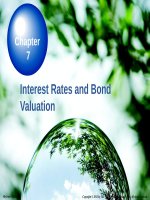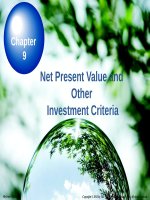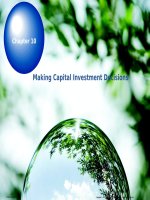Fundamentals of coroprate finance 7th ross westerfield CH02
Bạn đang xem bản rút gọn của tài liệu. Xem và tải ngay bản đầy đủ của tài liệu tại đây (421.18 KB, 46 trang )
Chapter
2
•Financial Statements, Taxes,
and Cash Flow
McGraw-Hill/Irwin
Copyright © by The McGraw-Hill Companies, Inc. All rights
Chapter 02 – Index of Sample
Problems
•
•
•
•
•
•
•
•
•
Slide # 03 - 10
Slide # 11 - 12
Slide # 13 - 18
Slide # 19 - 20
Slide # 21 - 22
Slide # 23 - 24
Slide # 25 - 26
Slide # 27 - 28
Slide # 29 - 34
Understanding a balance sheet
Market value versus book value
Understanding an income statement
Earnings per share
Dividends per share
Average tax rate
Marginal tax rate
Operating cash flow
Net capital spending
(index continued on next slide)
Chapter 02 – Index of Sample
Problems
•
•
•
•
Slide # 35 - 36
Slide # 37 - 38
Slide # 39 - 41
Slide # 43 - 44
Change in net working capital
Cash flow from assets
Cash flow to creditors
Cash flow to stockholders
3: Understanding a balance sheet
Answer these questions based on the balance sheet shown on slide #
4. Use 2005 values.
1.
2.
3.
4.
5.
What is the amount of the current assets?
What is the amount of the long-term assets?
What is the amount of the current liabilities?
What is the amount of the long-term debt?
What is the amount of the stockholders’ equity?
Answers on slide # 5.
4: Understanding a balance sheet
WISDOM, INC.
Balance Sheets
($ in millions)
2004
Assets
Cash
2005
Liabilities and Owners’ Equity
$ 199
$
203
Accounts payable
Notes payable
Accounts receivable
436
421
Inventory
504
497
1,139
1,121
1,574
1,633
Total
Net fixed assets
2004
Total
Long-term debt
Total
Common stock and paid
in surplus
Retained earnings
Total
Total assets
$2,713
$2,754
Total liabilities and
owners’ equity
2005
$ 219
$ 187
193
546
412
733
470
533
882
1,266
690
650
1,141
838
1,831
1,488
$2,713
$2,754
5: Understanding a balance sheet
Answers to questions from slide # 3.
Current assets for 2005 = $203m + $421m + $497m
= $1,121m
Long term assets for 2005 = $1,633m
Current liabilities for 2005 = $187m + $546m
= $733m
Long - term debt for 2005 = $533m
Stockholders' equity for 2005 = $ 650m + $838m
= $1,488m
6: Understanding a balance sheet
The Dinmore Company has total assets of $6.4 million, current assets of
$2.3 million, current liabilities of $2.5 million and total liabilities of $4.2
million.
1.
2.
3.
4.
What is the amount of the stockholders’ equity?
What is the amount of the net working capital?
What is the amount of the long-term assets?
What is the amount of the long-term debt?
Answers on slides # 7-8.
7: Understanding a balance sheet
Answers to slide # 6.
Stockholders' equity = Total assets - Total liabilities
= $6.4m - $4.2m
= $2.2m
Net working capital = Current assets - Current liabilities
= $2.3m - $2.5m
= - $0.2m
8: Understanding a balance sheet
Answers to slide # 6.
Long - term assets = Total assets - Current assets
= $6.4m - $2.3m
= $4.1m
Long - term liabilities = Total liabilities - Current liabilities
= $4.2m - $2.5m
= $1.7m
9: Understanding a balance sheet
Your company has current assets of $250 million, total assets of $395
million and long-term debt of $116 million. The net working capital is
$19 million.
1. What is the amount of the current liabilities?
2. What is the amount of the total equity?
Answers on slide # 10.
10: Understanding a balance sheet
Net working capital = Current assets - Current liabilities
Current liabilities = Current assets - Net working capital
= $250m - $19m
= $231m
Total liabilities = Current liabilities + Long - term liabilities
= $231m + $116m
= $347m
Total equity = Total assets - Total liabilities
= $395m - $347m
= $48m
11: Market value vs book value
The balance sheet of your firm shows current assets of $214,500 which
includes cash of $23,600, accounts receivable of $87,500 and
inventory of $103,400. Long-term assets have a book value of
$487,300 which is comprised of a building and some equipment.
You believe you can sell the inventory for $163,900. You expect to
collect only $84,600 of the accounts receivables. You can sell the
equipment for $218,000 and the building for $365,000.
What is the total book value of your firm? The total market value?
12: Market value vs book value
Book Value
Market Value
Current assets
$214,500
$272,100
Long-term
assets
$487,300
$583,000
Total assets
$701,800
$855,100
13: Understanding an income
statement
MALLORY, INC.
2005 Income Statement
($ in millions)
Net sales
Cost of goods sold
Depreciation
Earnings before interest and taxes
Interest paid
Earnings before taxes
Taxes
Net income
Dividends paid
Addition to retained earnings
$2,179
1,806
139
???
48
???
63
$ ???
$ 50
$???
Can you find the missing values?
14: Understanding an income
statement
MALLORY, INC.
2005 Income Statement
($ in millions)
Net sales
Cost of goods sold
Depreciation
Earnings before interest and taxes
Interest paid
Earnings before taxes
Taxes
Net income
Dividends paid
Addition to retained earnings
$2,179
1,806
139
234
48
186
63
$ 123
$50
$73
Calculations shown on next slide
15: Understanding an income
statement
Earnings before interest and taxes = Net sales - Cost of goods sold - Depreciation
= $2,179m - $1,806m - $139m
= $234m
Earnings before taxes = Earnings before interest and taxes - Interest paid
= $234m - $48m
= $186m
Net income = Earnings before taxes - Taxes
= $186m - $63m
= $123m
Addition to retained earnings = Net income - Dividends
= $123m - $50m
= $73m
16: Understanding an income
statement
FISCHER, INC.
2005 Income Statement
($ in millions)
Net sales
Cost of goods sold
Depreciation
Earnings before interest and taxes
Interest paid
Earnings before taxes
Taxes
Net income
Dividends paid
$
Addition to retained earnings $ 121
Can you find the missing values?
$1,067
731
64
???
32
???
???
$ ???
35
17: Understanding an income
statement
FISCHER, INC.
2005 Income Statement
($ in millions)
Net sales
Cost of goods sold
Depreciation
Earnings before interest and taxes
Interest paid
Earnings before taxes
Taxes – 35%
Net income
Dividends paid
Addition to retained earnings
$1,067
731
64
272
32
240
84
$ 156
$ 35
$121
18: Understanding an income
statement
Net income = Dividends paid + Addition to retained earnings
= $35 + $121
= $156
Net income
1 - Tax rate
$156
=
1 − .35
$156
=
.65
= $240
Earnings before taxes =
Earnings before interest and taxes = Earnings before taxes + Interest paid
= $240 + $32
= $272
19: Earnings per share
Your firm has net income of $210,000. You own 140,000 shares of stock
and are the only stockholder.
What is the amount of your earnings per share?
20: Earnings per share
Net income
Number of shares outstanding
$210 ,000
=
140 ,000
= $1.50
Earnings per share =
21: Dividends per share
Your firm has net income of $210,000. The number of outstanding
shares of common stock is 140,000. The dividend payout ratio is 40%.
What is the amount of the dividends per share?
22: Dividends per share
Net income × Dividend payout ratio
Number of shares outstanding
$210 ,000 × .40
=
140 ,000
$84,000
=
140,000
= $0.60
Dividends per share =
23: Average tax rate
Given this tax table, what is the average tax rate for a firm with
taxable income of $160,000?
Taxable Income
Tax Rate
0-
50,000
15%
50,001-
75,000
25%
75,001-
100,000
34%
100,001-
335,000
39%
24: Average tax rate
Taxable Income
$50,000 × .15 = $ 7,500
$25,000 × .25 = $ 6,250
$25,000 × .34 = $ 8,500
($160,000 − $100,000) × .39 = $23,400
Total tax = $45,650
Total tax
Taxable income
$45,650
=
$160,000
= .2853125
≅ 28.53%
Average tax rate =
Tax Rate
0-
50,000
15%
50,001-
75,000
25%
75,001-
100,000
34%
100,001-
335,000
39%









